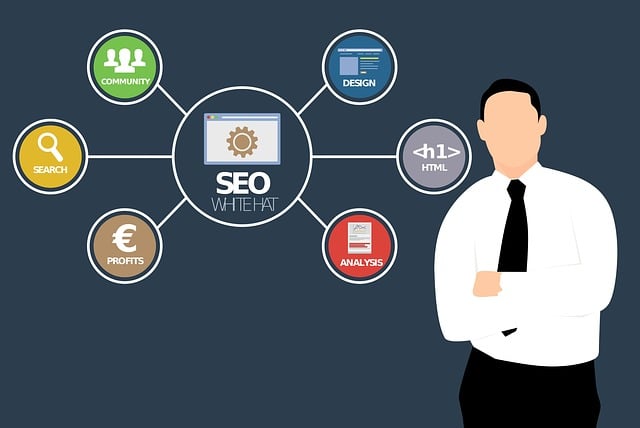Competitive SEO analysis is a powerful method for businesses aiming to boost online visibility by studying their website and competitors' performance. It involves keyword research, backlink analysis, and content strategy evaluation. By identifying high-value keywords, replicating successful tactics, and improving areas like on-page optimization, mobile responsiveness, content creation, and local SEO, businesses can outrank rivals on search engine results pages. Advanced SEO strategies also emphasize link building through partnerships, guest blogging, and creating valuable, location-specific content to attract and retain audiences in competitive markets. Leveraging cutting-edge tools for detailed analytics ensures constant adaptation to market changes and algorithm updates, maintaining a strong online presence.
Competitive SEO Analysis is an indispensable strategy for any business aiming to dominate its industry. By examining the tactics of top-ranking competitors, businesses can uncover valuable market insights and develop effective advanced SEO strategies. This comprehensive guide explores key components from identifying primary rivals to implementing on-page optimizations, content creation, link building, local SEO, and utilizing advanced tools—all vital for staying ahead in today’s digital landscape.
Understanding Competitive SEO Analysis: Unlocking Market Insights

Competitive SEO analysis is a powerful tool for businesses aiming to master their online visibility. It involves an in-depth examination of a company’s website and its competitors’ digital performance, offering valuable insights into market trends and user behavior. By employing advanced SEO strategies, marketers can gain a competitive edge. This process includes evaluating keyword rankings, analyzing backlinks, and understanding the content strategies employed by top performers.
Through this analysis, businesses uncover hidden opportunities and threats within their industry. It reveals which keywords drive organic traffic, identifies successful competitor tactics, and highlights areas for improvement. With these market insights, companies can refine their SEO approaches, create more effective content, and ultimately, outrank competitors in search engine results pages.
Identifying Key Competitors: Mapping Your Digital Landscape

Identifying key competitors is a crucial step in any advanced SEO strategy. It involves mapping your digital landscape to understand who your main rivals are online and what approaches they’re employing to attract customers. Start by researching industry leaders, brands that offer similar products or services, and local businesses with strong online presences. Utilize tools like Google Search Console, SEMrush, Ahrefs, or Moz to gain insights into these competitors’ backlink profiles, content strategies, keyword rankings, and user engagement metrics.
This process allows you to identify gaps in your competition’s digital offerings and discover opportunities for differentiation. By analyzing their strengths and weaknesses, you can tailor your SEO efforts to target specific keywords, optimize content for better user experience, and implement effective link-building strategies that set you apart in the crowded online marketplace.
On-Page Optimization: A Deep Dive into Technical SEO

On-Page optimization is a critical component of any robust Competitive SEO Analysis, delving deep into the technical aspects that underpin website performance. It involves optimizing individual web pages to rank higher and earn more relevant traffic in search engine results pages (SERPs). Advanced SEO strategies here encompass a range of techniques, from ensuring mobile-friendliness and fast loading speeds to implementing structured data markup and enhancing internal linking. These tactics not only improve user experience but also signal to search engines the relevance and quality of your content.
By focusing on these technical intricacies, businesses can ensure their websites are crawlable and indexable efficiently. Search engine crawlers navigate sites based on specific algorithms, and optimizing for these algorithms is key to visibility. This includes addressing issues like broken links, optimizing meta tags and descriptions, and utilizing header tags effectively. Such meticulous On-Page optimization lays a solid foundation for competitive SEO, enabling websites to stand out in crowded markets and attract the right audience through organic search results.
Content Strategy: Creating a Powerful Content Arsenal

A robust content strategy is a cornerstone of any successful Advanced SEO Strategies. It involves meticulously planning, creating, and optimizing content to meet the evolving needs and preferences of your target audience while aligning with search engine algorithms. A powerful content arsenal includes a diverse mix of high-quality blog posts, informative infographics, engaging videos, and interactive quizzes, all tailored to address user intent and drive organic traffic.
By employing strategic keyword research and on-page optimization techniques, you can ensure that your content is not only compelling but also search engine friendly. Integrating keywords naturally into headings, meta descriptions, and body text enhances visibility while maintaining a reader-centric approach. This balance between SEO best practices and user experience is key to attracting and retaining audiences, ultimately boosting your website’s authority and rankings in competitive online environments.
Link Building Tactics: Earning High-Value Backlinks

Link building is a cornerstone of advanced SEO strategies, and mastering it involves earning high-value backlinks from reputable sources. This process goes beyond simple link acquisition; it’s about fostering strategic partnerships that enhance your website’s authority and visibility. One effective tactic is guest blogging on influential industry blogs, where you can contribute valuable content while naturally inserting links back to your site. Another powerful method is creating comprehensive resources, such as in-depth guides or research papers, which are likely to be linked to by other websites in the same niche.
Leveraging broken link building is another sophisticated technique. You identify broken links on relevant websites and offer your content as a replacement, securing a high-quality backlink in the process. Additionally, leveraging influencer partnerships can significantly boost your backlink profile. By collaborating with industry influencers, you gain access to their engaged audiences and often receive backlinks from their well-established platforms. These advanced link building tactics, when implemented strategically, can propel your website’s SEO performance to new heights.
Local SEO Considerations: Capturing Geographic Markets

In the realm of Advanced SEO Strategies, Local SEO Considerations are paramount for capturing geographic markets and expanding business reach. Understanding your target audience’s location is crucial; businesses can optimize their online presence to attract local customers by leveraging tools like Google My Business. This strategy ensures that potential clients searching within a specific area find and engage with your brand promptly.
By integrating local keywords, creating location-specific content, and encouraging customer reviews, businesses can enhance their visibility on search engines. These tactics not only improve organic search rankings but also build trust and credibility among local audiences. Effective Local SEO is a game-changer, transforming online presence into tangible results by driving targeted traffic and boosting conversions from the captured geographic markets.
Advanced Tools and Metrics: Measuring Success and Staying Ahead

In today’s digital landscape, advanced SEO strategies and tools are indispensable for staying ahead in search engine rankings. These cutting-edge metrics go beyond basic keyword research and page optimization. They include sophisticated analytics that track user behavior, site performance, and backlink profiles to provide a holistic view of a website’s online presence. By leveraging these advanced tools, businesses can gain valuable insights into their target audience, identify areas for improvement, and refine their content strategies accordingly.
Staying ahead in SEO requires constant adaptation to algorithm updates and evolving user preferences. Advanced tools enable marketers to monitor these changes proactively. They can track keyword trends, analyze competitor strategies, and measure the success of various campaign efforts with precision. This data-driven approach ensures that SEO strategies remain effective and relevant, keeping websites at the top of search results even in highly competitive industries.
